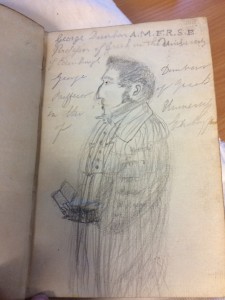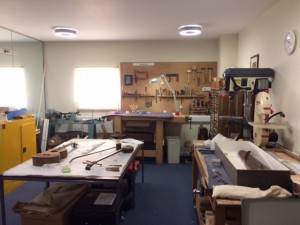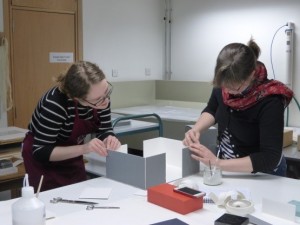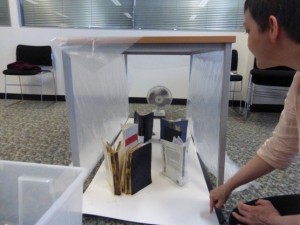In this post, Technician Robyn Rogers discusses her bespoke mounting and rehousing of loose-leaf papers from the University’s decorated paper collection. Robyn’s first post about working through the collection’s bound volumes can be seen here. If you are interested in learning more about the historic uses, production and trade of decorated paper, you can visit the online exhibition on this collection, curated by Elizabeth Quarmby Lawrence here.
Tag Archives: Preventative Conservation
Collections Care Task Days
In this post, Technician Robyn Rogers discusses the first events in series of Collection Care Task Days at the University of Edinburgh Heritage Collections.
E-learning with Employ.ed
Today we hear from Sophie, our first ever Employ.ed student in the conservation studio…
Hi, my name is Sophie Lawson and I am currently the Conservation E-learning intern at the Centre for Research Collections at the University of Edinburgh. During my time of ten weeks here in the Conservation Department I will be creating an electronic learning resource on the subject of Integrated Pest Management (IPM). My internship is part of the Employ.ed programme, which is a University run scheme that supports students’ career development, providing work experience whilst working towards attaining the Edinburgh Award. I am currently going into my third year of my undergraduate degree in History and have an interest in special collections, particularly in digitisation and use of technologies in the heritage sector.
The University’s IPM plan is integral to the storage of rare and unique collections, being a tested method to monitor and control insect pests and mould activity in collections that, if left unmonitored or untreated, could cause irreversible and expensive damage to collection items. As part of a preventive conservation programme, IPM is an effective way to reduce damage and cost, and to minimise intervention with special collection items. An effective IPM plan will enable institutions to have greater control over and knowledge of pest activity in their facility, making pest prevention and treatment much more effective. One of my goals through creating this e-learning resource is to aid this accumulation of knowledge of pest activity throughout the department, with the hope that the resource will be used for internal staff training for a basic overview of our IPM plan, how it works and why it is so important.

Using a microscope to identify pests
So far in my internship I have been able to gain invaluable insight into the field of Conservation, having spent some time in the Historic Environment Scotland’s Conservation Studio, as well as our own in the CRC, and even being able to try my hand at some surface cleaning and making boxes for rehousing books! More specifically I have gained a great deal of knowledge about Preventive Conservation, having researched Integrated Pest Management and the theory behind it for the content of my e-learning resource. In addition to this, I have been able to shadow my supervisor, Katharine Richardson, as she carried out pest trap inspections as part of our IPM Plan – and was even able to get a closer look at the kind of pests we found!

Trap used to monitor for pest activity
For the remainder of my internship I aim to create a user directed, interactive program, and experiment with implementing different types of media such as games and video tutorials to create an engaging and educational resource. I hope that through the completion of this project we are able to generate a broader knowledge of IPM and its importance amongst the University’s Centre for Research Collections staff, as well as introduce new methods of e-learning and training styles to be used in the department in future projects.
Boxing Clever
Rehousing is a key part of conservation. But why is it so important? Find out in this week’s blog from Special Collections Conservator, Emily…
We recently received a large number of drop spine boxes to house the Laing Western manuscript collection. This was a part of a month-long project to conserve this collection, which you can read more about by following this link. These boxes are handmade to match the exact dimensions of the book. Not only do they look great on the shelves, they also provide excellent protection for the books. However, they are relatively expensive and time consuming to make. So the creation of these boxes is often outsourced, and reserved for our most important collections.

Laing manuscript collection, before rehousing

Laing manuscript collection, after rehousing
A Fond Farewell
For the last ten weeks I have been working with Project Conservator, Emily Hick to conserve and rehouse a collection of rare Greek books. The weeks have gone racing by and now my internship has come to an end. In light of this, I would like to share a bit more about my internship experience at the Centre for Research Collections.
Working on the Blackie project with Emily has been a great way to gain insight into the planning and management of conservation projects. One of my responsibilities as intern was to record the time it took me to complete each task and the materials I used in the process. This was a really useful exercise as it made me think of how I could work more efficiently and be more resourceful with materials. I now feel that I am better equipped to plan and manage conservation projects myself in the future.
One of the great advantages of working on a project involving Greek books is that I can’t stop and read them! However, I have occasionally found some quirky things in the collections to distract me. My favourite by far is this doodle on the endpaper of an eighteenth century book. The image is of George Dunbar, professor of Greek at Edinburgh University from 1807 to 1851. It looks as if it may have been drawn by one of his students!?

Sketch of George Dunbar, Professor of Greek at Edinburgh University from 1807 -1851
My background is in Preventive Conservation so the internship has been an excellent opportunity to become more familiar with paper conservation. I have been able to learn a lot more about the interventive treatments of paper just by observing Emily and the other conservators at work. As most cultural heritage collections contain paper objects and books, the value of this knowledge cannot be understated. I thoroughly enjoyed having a go at some basic interventive conservation treatments during a Conservation Taster Day held at the CRC, where I learned to do tear repairs and infills on de-accessioned documents.

Having fun making tear repairs during the conservation taster day
As a Preventive Conservator, I feel it is important to have a broad understanding of all materials and objects found in cultural heritage collections. Therefore, it has been particularly helpful for me to visit different parts of the University’s collections to learn how they are cared for. I have been able to visit the Musical Instrument Collections, the Anatomy Museum and the Art Collections. I was fascinated to learn about the treatments and techniques employed in the conservation of musical instruments. During my visit to the anatomy museum I was interested to learn about the practical ethical challenges in caring for collections of human remains.

Musical instrument conservation studio
Throughout the internship I have had access to training, which has significantly improved my knowledge and skills in both preventive and remedial conservation. I have received training on rehousing, disaster planning and designing collections databases. The training will undoubtedly improve my chances of finding employment once the internship concludes. I have also been able to get an idea of what is involved in running a staff training day by assisting Emma Davey, Conservation Officer, in preparing for the disaster response and salvage training.

Learning to make temporary boxes for books

Building wind tunnels during salvage training
I have thoroughly enjoyed my time working with the Conservation Department at the CRC. I have been encouraged to get involved in all aspects of the Department’s work, from conservation and collections care, to public engagement activities. As a new graduate, the internship has allowed me to put the knowledge gained from my Masters degree into practice and given me more confidence in my abilities. The conservation team have all been very supportive and have given me lots great advice on career development. All in all, I think an internship with the CRC is an excellent opportunity for a new graduate, and I would strongly recommend it to anyone starting out in conservation.
